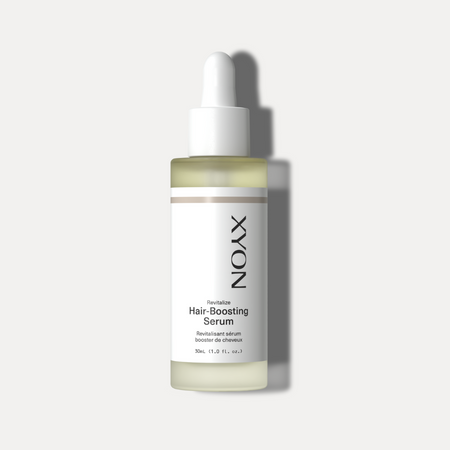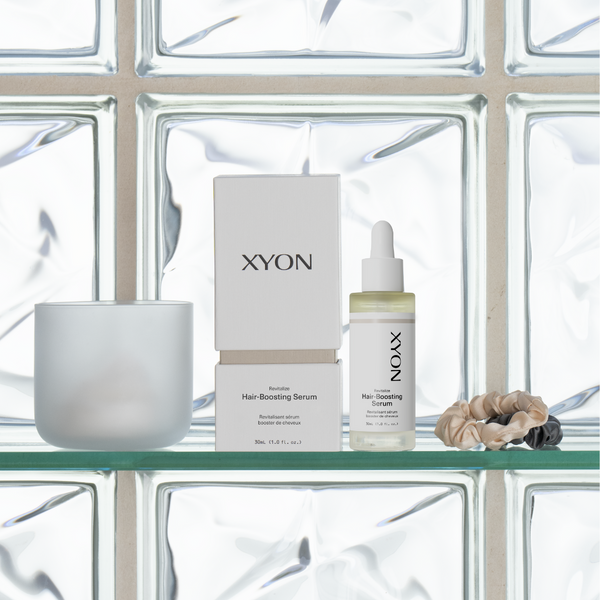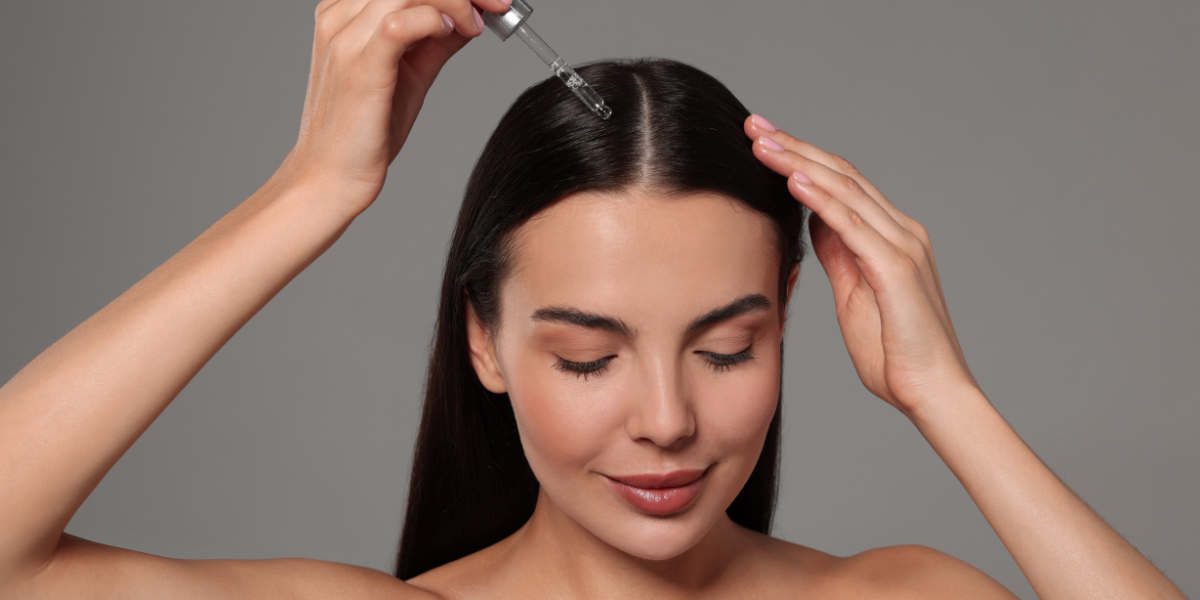Growth factors have existed in the beauty space for some time, but what’s been somewhat overlooked is their value in hair products. These small protein fragments play an important part in various biological processes, but there are some that contribute directly to the hair growth cycle to help promote healthy, thick hair.
Here’s why growth factors could be a great addition to your haircare routine.


Our Revitalize Hair-boosting Serum Contains Growth Factors VEGF and FGF
Nourish your scalp with this weightless hair serum featuring a unique blend of growth factors and moisturizers to promote hair growth.
The role of growth factors in cosmetics
Put simply, growth factors are fragments of proteins naturally occurring in all cells around the body that send out signals within and between cells to influence cell behavior. Since their discovery in the 1980s, the regenerative properties of growth factors have been recognized and utilized in medicine to help with wound repair.
After seeing these benefits, the cosmetics industry has started incorporating them into a variety of skin care products under the premise that they may be able to slow down or reverse some of the effects of aging, such as wrinkles and fine lines. Topical application of growth factors is believed to promote collagen production and strengthen the skin barrier and there's been some promising research to support this theory. For example, a study looking at the effects of using a topical gel containing growth factors on skin damaged by the sun, found that 11 out of 14 participants showed a clinical improvement in at least one area of the face, including improvements in fine lines and facial texture (Fitzpatrick & Rostan, 2003).
But the benefits of growth factors aren’t limited to skin care– they may also help with hair growth. Numerous growth factors are believed to have similar rejuvenating effects on the scalp and hair and they may be the next best ingredient to consider adding into your hair care routine.
Remember that growth factors have specific effects and different growth factors induce different cellular responses. This means that when selecting growth factors for the hair, it’s crucial that the right ones are chosen to ensure it will produce the desired effect.
When it comes to adding growth factors to hair care products, there are two growth factors have been identified as potentially useful in supporting the growth and development of hair follicles:
- Vascular endothelial growth factor (VEGF)
- Fibroblast growth factor (FGF)
Below, we break down these two growth factors and explain how they can benefit your hair and scalp.
Vascular endothelial growth factor (VEGF)
VEGF is a growth factor that’s believed to mediate cell division and formation of blood vessels (Miele et al, 2000).VEGF acts primarily on the dermal papilla cells located just under the hair follicle.
In hair follicle cells, VEGF stimulates the growth of tiny blood vessels, called capillaries. This process is known as angiogenesis and it plays an important role in hair growth, since it improves the supply of oxygen and key nutrients to the scalp. In fact, research has shown that blood vessel growth is heavily involved in hair growth, with findings that rich capillaries surrounding hair follicles disappear when the follicle is transitioning into the resting and shedding phase of the hair growth cycle (Woo et al, 2019).
It’s also been noted that the amount of VEGF produced at the hair follicles seems to directly correlate to the amount of hair growth and the thickness of hair strands. For example, a mouse study used Lactobacillus plantarum hydrolysates, which is a compound known to increase VEGF production, to measure hair growth in mice (Woo et al, 2019). Researchers compared this to 5% topical minoxidil and found that the Lactobacillus plantarum hydrolysates were superior at producing visible improvements in hair growth after 14 days.
But can the same processes be stimulated when applying VEGF to the scalp topically, such as via a hair serum?
It appears so. In fact, topical VEGF has been proven to be an effective treatment for hair loss. For instance, a study treating patients suffering from alopecia areata with a gel containing 1% and 3% VEGF found an improvement in hair growth speed and hair thickness, compared to a placebo group (Gnann et al, 2013). Interestingly, the results showed that the hair follicle size increased with topical application of VEGF in a dose dependent manner. However, it’s important to bear in mind that VEGF doesn’t directly target the causes of hair loss, but it may be a useful supportive ingredient to incorporate into your routine, alongside a clinically proven hair loss medication.
Fibroblast growth factor (FGF)
FGF is another type of growth factor, also found in the hair and scalp cells and it’s believed to be a key regulator of the hair growth cycle. The term FGF encompasses a family of 22 growth factors and of those 22, a handful are noted to influence hair growth (Lin et al, 2015). It’s believed FGF encourages a larger proportion of hairs to enter the active growth stage of the hair cycle. Research to support this theory found that mice who received FGF treatment demonstrated significantly darker skin, compared to the group who didn’t receive FGF (Lin et al, 2015). It was proposed that the skin was darker due to more hairs entering the active growth phase of the hair cycle. However, it’s worth noting that this study involved injecting FGF into the mice, so the results of topical application may have been different.
A more recent study also concluded similar findings. In some mice, increased FGF levels were stimulated and this group experienced a shorter transition time from the resting phase of the hair growth cycle to the active growth phase (Woo et al, 2022). These findings support that FGF plays a key part in the hair growth cycle. However, there is a lack of research looking at topical FGF application for hair growth in humans. Having said that, there seems to be a consensus amongst researchers that FGF may be a useful component of hair loss therapies and further research would be beneficial.
How to incorporate growth factors into your haircare routine
If you suffer from hair loss or want to optimize your hair growth and thickness, you might consider adding growth factors into your routine. Women’s hair loss is a complex condition that can brought on by multiple factors. Because of this, it requires a more holistic approach to treatment compared to men’s hair loss. Knowing this, XYON has developed a biphasic hair serum, formulated with multiple active ingredients that target different aspects of women’s hair growth. It features VEGF and FGF along with other key ingredients, such as copper peptides that allow our hair serum to target the processes behind hair growth directly.
The hair serum’s unique biphasic formulation allows for the inclusion of multiple types of hair growth supporting ingredients which can be conveniently applied to affected areas of the scalp without leaving behind a greasy feel. Unlike shampoos and conditioners, hair serums aren’t rinsed away after application, giving the active ingredients enough time to interact with key structures in the scalp where they’re most beneficial.
Takeaway: growth factors in hair serum
Research has shown that the growth factors VEGF and FGF are largely involved in hair growth, making these ingredients potentially beneficial to those dreaming of thicker longer hair. These growth factors enhance hair growth by improving blood supply to hair follicles and positively influencing the hair growth cycle. In addition to our hair serum containing these powerful ingredients, XYON provides a variety of non-medicated options to support your hair and scalp health, helping you take the first steps towards achieving your hair goals.
References
Fitzpatrick, R.E., Rostan, E.F. (2003). Reversal of photodamage with topical growth factors: a pilot study. Journal of Cosmetic and Laser Therapy: Official Publication of the European Society for Laser Dermatology, 5(1), 25-34. https://doi.org/10.1080/14764170310000817
Gnann, L.A., Castro, R.F., Azzalis, L.A., Feder, D., Perazzo, F.F., Pereira, E.C., Rosa, P.C.P., Junqueira, V.B.C., Rocha, K.C., Machado, C.A., Paschoal, F.C., Abreu, L.C., Valenti, V.E., Fonseca, F.L.A. (2013). Hematological and hepatic effects of vascular epidermal growth factor (VEGF) used to stimulate hair growth in an animal model. BMC Dermatology, 13. https://doi.org/10.1186/1471-5945-13-15
Lin, W.H., Xiang, L.J., Shi, H.X., Zhang, J., Jiang, L.P., Cai, P.T., Lin, Z.L., Lin, B.B., Huang, Y., Zhang, H.L., Fu, X.B., Guo, D.J., Li, X.K.., Wang, X.J., Xiao, J. (2015). Fibroblast growth factors stimulate hair growth through β-catenin and Shh expression in C57BL/6 mice. BioMed Research International. https://doi.org/10.1155/2015/730139
Miele, C., Rochford, J.J., Filippa, N., Giorgetti-Peraldi, S., Obbergen, E.V. (2000). Insulin and insulin-like-growth factor-I induce vascular endothelial growth factor mRNA expression via different signaling pathways. The Journal of Biological Chemistry, 275(28), 695-702. https://doi.org/10.1074/jbc.m000805200
Woo, J., Suh, W., Sung, J.H. (2022). Hair growth regulation by fibroblast growth factor 12 (FGF12). International Journal of Molecular Sciences, 23(16) https://doi.org/10.3390/ijms23169467
Woo, Y.M., Kim, O.J., Jo, E.S., Jo, M.Y., Ahn, M.Y., Lee, Y.H., Li, C., Lee, S.H., Choi, J.S., Ha, J.M., Kim, A. (2019). The effect of Lactobacillus plantarum hydrolysates promoting VEGF production on vascular growth and hair growth of C57BL/6 mice. Journal of Analytical Science and Technology, 10 (18). https://jast-journal.springeropen.com/articles/10.1186/s40543-019-0178-0#citeas




